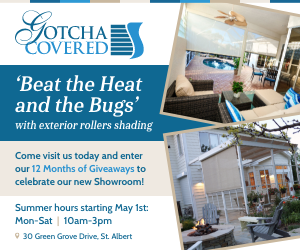Trending
Gotta Run: Bringin’ it back to basics
December, 2015
Running. It’s in our genes. Long before obtaining food meant a quick drive to the nearest grocery store or restaurant, human beings relied on their natural running ability to gather or hunt for food. In fact, when it comes to running long distances at a slow and constant pace, people (even today) are at the top of the heap among mammals.
However, nowadays with adults and school-aged kids spending the majority of their days behind a desk, running can often seem like an unnatural thing to do. Alas, there is good news: regardless of your shape, size, age or ability, if you put foot to pavement, your body will know what to do! With the help of Edmonton physiotherapist and six-time Ironman competitor, Laurie Plouffe, here’s a glimpse of five basic running techniques and styles that will help you get your sweat on.
Pose
What it is: Pose refers to the vertical alignment of the whole body (shoulders, hips and ankles with the support leg, while standing on the ball of that foot). The body forms an S-like position with slightly bent knees. When a runner leans forward from the ankles, gravity is activated; therefore, the body remains in a forward momentum. The feet are being pulled up under the hips (not buttocks), and the ball of the runner’s foot then lands under his or her body.
When the runner changes the pose from one leg to the other and falls forward to allow gravity to do the work, this simple sequence of movements is referred to as “the fall and the pull.” Learning how to fall and making the best use of gravity is the most essential step in adopting the pose technique.
Best suited for: Pose suites everyone because it decreases impact through the joints, especially the knees. This technique is used by athletes and non-athletes of all levels and ages—anyone who’s had an injury can benefit.
Muscles worked: The runner’s lower leg, calf and foot muscles are worked because of the fore-to-mid foot strike with the ground. This part of the body acts like a spring. Gluteus muscles are activated when the runner pushes off, and a slight forward lean engages core body strength.
Advantages: The forward movement of this technique makes it extremely efficient as it uses a low amount of energy and effort. It’s also considered low-impact, which decreases body stress and, therefore, the risk of injury.
Disadvantages: People new to this technique may notice sore calf muscles and feet because of the lower legwork. Once a runner’s calves adapt, they become extremely efficient.
Chi
What it is: Pronounced “chee,” this running technique is based on the principles of Tai Chi. You don’t, however, need any knowledge of martial arts to adopt this run—only an understanding of how core engagement works.
Chi uses the mind-body connection (in addition to core engagement) in an effort to make legwork feel effortless. Energy moves from the core into the limbs (which are relaxed) to create movement. So instead of pushing or pulling a runner’s body forward, the runner’s legs are simply supporting his or her body weight.
Allowing gravity to propel the runner forward while landing with a mid-foot strike and maintaining proper alignment and posture are key to this technique. When muscles and joints are relaxed, chi can flow freely through the body.
Best suited for: Long-distance runners and sprinters can use this technique because it’s efficient and produces less stress on the body. This technique is also suited to people who’ve had injuries or are open to finding “life force energy” to create a centered and balanced approach to running.
Muscles worked: To maintain a proper spine position, runners need to engage their core and lower back muscles. Gluteus muscles help propel runners forward, and leg and foot muscles are used to maintain a mid-foot strike.
Advantages: When a runner has a strong core, all of his or her movements become more efficient—which helps prevent fatigue. Because relaxed limbs move easily, there’s less impact and, therefore, less chance of injury.
Disadvantages: Initially, it might take an investment in time to get all of the different muscle groups working in a runner’s favour.
Gazelle
What it is: Gazelle is considered more of a style than a technique. People who embrace this style not only make use of gravity by leaning forward but also achieve a large spring in their step, which produces great flight between their strides.
A strong, high-knee drive is the central characteristic of this style of running. More distance is covered between strides with a foot strike slightly or directly underneath a runner’s centre of gravity.
Best suited for: Long-distance runners often favour this style because of the long flight time and efficient stride. People with long legs and natural body elasticity also gravitate towards this style because of the amount of vertical displacement.
Muscles worked: Strong core for posture, excellent hip mobility and powerful gluteus muscles are needed for this style of running. Calf and foot muscles are also engaged.
Advantages: Gazelle is an efficient style because its springy nature allows a runner to soar through the air at almost no energy cost.
Disadvantages: If done improperly with a foot strike ahead of the centre of gravity, (instead of underneath it), a runner could inadvertently encourage a painful heel strike.
Glider
What it is: Like gazelle, glider is considered a running style, not a technique. Runners who are gliders tend to stay close to the ground and maintain a quick leg turnover. In other words, there’s not a lot of vertical displacement between the foot and
the ground.
Similar to skating, the glider movement is fully open at the hip with the front foot swinging out in front of the body—which generates forward velocity. People who adopt this style employ a more upright posture, with a slight lean forward and a low knee. The runner’s foot strike is underneath his or her centre of gravity.
Best suited for: Newer runners and people looking to sustain a slower pace for longer distances might prefer this style. Also, those looking for less impact might be better suited to this type of run.
Muscles worked: Hip-flexors and hamstrings are activated in order to maintain a strong leg swing. Good core strength is needed for ideal posture.
Advantages: Glider can be a very efficient run because strides are very short.
Disadvantages: While there may be less impact on landing, there is a risk that a runner’s hips and hamstrings could become overused.
Barefoot
What it is: A runner makes short efficient strides with a forefoot strike, taking full advantage of the natural springs in his or her feet and calf muscles to propel themselves forward. The idea is to gently land on your forefoot and gradually let the heel come down.
Best suited for: Anyone can adopt this run because it uses a person’s own intrinsic cushioning system. Runners, however, are strongly encouraged to build up their tolerance slowly to avoid injury.
Muscles worked: Foot and calf muscles are strongly engaged.
Advantages: Barefoot running strengthens muscles in your feet, legs and gluteus—core engagement is also essential. When done properly, the risk of injury could be low.
The bouncing nature of barefoot running makes it energy efficient.
Disadvantages: If you consider yourself a heel striker, your first attempts at going barefoot could be painful. Building up a gradual tolerance is recommended. Invest time to train your body to forefoot strike, and build the required muscle strength in your feet and calves. Severe injury could take place otherwise. t8n
“There is no such thing as perfect running form—it’s a gift from your parents […] To try and dramatically change a runner’s form usually leads to injury. You can do slight enhancements to make a runner more efficient, but to recommend all runners run the same is like saying we must all have the same body types.”
–John Stanton, CEO and founder
of the Running Room












